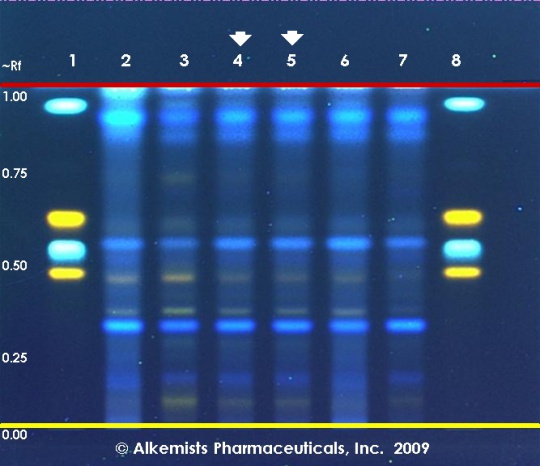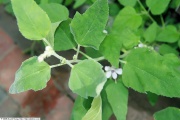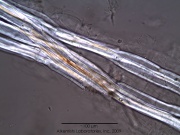|
|
| Line 1: |
Line 1: |
| − | =Introduction= | + | =Nomenclature= |
| | + | |
| | + | {{nomenclature | binomial=Althaea officinalis |
| | + | |authority=L. |
| | + | |family=Malvaceae |
| | + | |scn=marshmallow |
| | + | |syn= |
| | + | |ayurvedic= |
| | + | |pinyin= |
| | + | |aka=althaea; althea |
| | + | |notes= }} |
| | + | |
| | =Macroscopic Entries= | | =Macroscopic Entries= |
| | {{Macroscopy | source=United States Dispensatory (1918) | | {{Macroscopy | source=United States Dispensatory (1918) |
Revision as of 15:59, 13 March 2014
Nomenclature
Althaea officinalis L. Malvaceae
Standardized common name (English): marshmallow
Macroscopic Entries
| Althaea officinalis is an herbaceous perennial,
with a perpendicular branching root and erect woolly stems, from two to four feet or more in height, branched and leafy towards the summit. The flowers are terminal and axillary, with short peduncles, each bearing one, two, or three flowers. The corolla has five spreading, obcordate petals, of a pale rose color. The fruit consists of numerous capsules united in a compact circular form, each containing a single seed.
Althaea is usually cut into small pieces about 5 mm. in diameter, of a uniform grayish-white color and otherwise having the characters of entire roots; occasionally entire, slenderly tapering, attaining a length of 30 cm. and a thickness of 2 cm., externally whitish, longitudinally furrowed, frequently spirally twisted and covered with the somewhat loosened bast-fibers; fracture of bark fibrous, of wood short and granular; internally yellowish-white; bark 1 to 2 mm. thick, porous, due to mucilage cells, and separated from the slightly radiating wood by a distinct, grayish cambium zone; odor slight; taste sweetish, mucilaginous.
Source: United States Dispensatory (1918) [1]
|
|
|
|
Microscopic Entries
| Bast fibers observed at 400x with Acidified Chloral Hydrate Glycerol Solution.cellular structures identified in this botanical specimen are bast fibers and the mucilage bearing parenchyma cells with a rosette of calcium oxalate when observed at 400x with Acidified Chloral Hydrate Glycerol Solution.
Source: Elan M. Sudberg, Alkemist Laboratories [3]
|
|
|
|
| The powder is whitish;
starch grains numerous, from 0.003 to 0.02 mm. in diameter, usually with a long cleft at the point of origin of growth; sclerenchymatous fibers in groups, the walls being quite thick and more or less lignified; trachese with scalariform thickenings or with bordered pores; calcium oxalate crystals few, in rosette aggregates from 0.02 mm. to 0.03 mm. in diameter.
Source: United States Dispensatory (1918) [4]
|
|
|
|
HPTLC Entries

Althaea officinalis HPTLC ID - Natural Product Reagent + PEG UV 365 nm
Marshmallow (root) (Althaea officinalis)
Lane Assignments Lanes, from left to right (Track, Volume, Sample):
- 1 μL Caffeic acid, Chlorogenic Acid, Hyperoside, Rutin ~0.1% in CH3OH
- 3 μL Althaea officinalis-1 (root)
- 3 μL Althaea officinalis-2 (root)
- 3 μL Althaea officinalis-3 (root)
- 3 μL Althaea officinalis-3 (root)
- 3 μL Althaea officinalis-4 (root)
- 3 μL Althaea officinalis-5 (root)
- 1 μL Caffeic acid, Chlorogenic Acid, Hyperoside, Rutin ~0.1% in CH3OH
Reference materials used here have been authenticated by macroscopic, microscopic &/or TLC studies according to the reference source cited below held at Alkemists Pharmaceuticals, Costa Mesa, CA.
Stationary Phase Silica gel 60, F254, 10 x 10 cm HPTLC plates
Mobile Phase ethyl acetate: glacial acetic acid: formic acid: water [10/1.1/1.1/2.4]
Sample Preparation Method 0.5 g + 5 mL MeOH sonicate/heat @ 50°C ~ 1/2 hr, cntrfg, evap w N2, qs 1mL MeOH
Detection Method Natural Product Reagent + PEG -> UV 365 nm
Reference see British Herbal Pharmacopoeia, 1996
Source: Elan M. Sudberg, Alkemist Laboratories [5]
|
Other Points of Interest
Cite error: <ref> tags exist, but no <references/> tag was found



